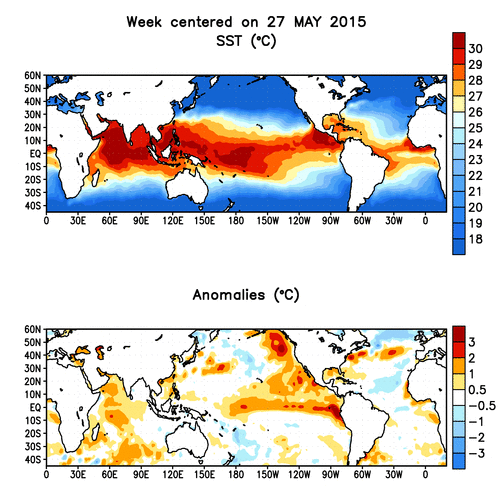
TOHO/SONY PICTURES
A scene from 1967's "Son of Godzilla."
This year’s El Niño might be the strongest ever. The phenomenon — marked by unusually warm waters in the Pacific Ocean off the coast of South America — means more precipitation could be on the way for Oklahoma. The state’s wheat farmers are hopeful, but know too much rain at the wrong time can be ruinous.
Mike Rosen runs a grain elevator near Kingfisher. He says Oklahoma’s wheat farmers can’t seem to catch a break.
“We’ve gone four years without moisture in the winter months, and it’s been kind of tough,” Rosen says. Then, when the drought finally broke it rained too much. “We had an average crop, but it was very poor quality because it rained so much during harvest. It just ruined the test weight and so forth.”
“For me it could be a bad deal. We’re dual purpose in this area, cattle and wheat, and you get a real wet winter like that, and the cattle out there chomping on that wheat, it can adversely hurt your yields. It could be thinning it out.
- Michael Peters
Rosen and dozens of other wheat producers gather at Redlands Community College in El Reno, where State Climatologist Gary McManus updated farmers on what could be the strongest El Niño ever.
“We’re going to call this the Godzilla El Niño,” McManus tells the crowd
But there’s no reason to panic. In fact, when this Godzilla El Niño was a baby, it helped stomp outthe state’s crippling drought. By mid-spring 2015, it looked like another disastrously dry summer was on the way.
“It didn’t stop raining for three months,” McManus told the farmers. “It rained and rained and rained.”
Now, the equatorial waters of the eastern Pacific are getting even warmer, and could break records. Mike Halpert with the National Oceanic and Atmospheric Administration says this El Niño is shaping up to be as big as super El Niños of the past, and water temperatures could reach 3.6-degrees above normal.

NOAA/National Weather Service
Weekly averaged sea surface temperatures (top) and anomalies (bottom) for the past 12 weeks.
That’s “a value that we’ve only recorded three times in the last 65 years,” Halpert said in a conference call with reporters: In periods from 1972-1973, 1982-1983 and 1997-1998.
The 2015 El Niño began much earlier than normal. Scientists aren’t sure why it’s so strong; research is ongoing and centers on climate change. Regardless, El Niño is here, and Oklahoma’s farmers are taking notice.
“At least the odds appear to be tilted more in our favor than they have been in quite some time going into the fall planting season,” McManus told the crowd.
The forecast for the fall and winter is especially important for winter wheat, which is Oklahoma’s No. 1 crop. McManus said data predict more storm systems from mid-fall through mid-spring.
“We would expect wetter than normal conditions, and sometimes cooler than normal temperatures go along with that,” he said.
The wetter-than-normal forecast had wheat farmers at the meeting cautiously excited. But each one sounds a note of caution as well, like Wheat Commission members and farmers Tom Stevens and Michael Peters.
“You could have freeze-out — freeze damage on wheat. Out in the panhandle, where I’m from, in Guymon, if we get real cold we like to have a snow cover, because it will protect that wheat from freeze-out.”
-Tom Stephens
What Oklahoma wheat farmers really like is the idea of more moisture when their crop is young, says north-central farmer Raymond Parrish.
“Usually it’s a pretty good thing, because you usually have more moisture and more snowfall, which covers the wheat, which helps it go through winter a lot easier,” he says. “The biggest deal is whether it starts raining in October and you can’t get your wheat in.”
But all El Niños are inherently unpredictable, and no one can say for certain what the oceanic phenomenon means for Oklahoma.
For example, the effects could stay too far south, in Mexico, which happened in the 1987 event. Or maybe, for once in several years, wheat farmers will get lucky.
“It’s always a good thing to be a little bit wetter,” Dewey County farmer Jimmy Emmons says. “We’d hate for it to be extremely cold, but it’s a good thing overall for us.”
Copyright 2021 StateImpact Oklahoma. To see more, visit StateImpact Oklahoma.


